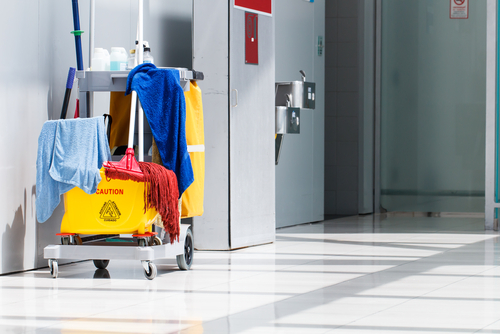As facilities managers and associates head into a new year, many are working to set goals that will cut costs, boost sustainability, and more. And learning how to meet those goals while maintaining a safe, hygienic workplace where building occupants can thrive might just be priority No. 1.

One of the most efficient ways to accomplish this is establishing streamlined cleaning processes and procedures. The following are three tips to ensure you are utilizing cleaning minutes efficiently in 2023.
1. Using Occupancy to Determine Frequency
There is a fine line between providing the highest levels of sanitation and overcleaning an area. Determining the correct frequency of cleaning is also made more difficult by the hidden nature of the contaminates, germs, and bacteria that we are looking to eliminate.
One way to combat this is by using data-driven cleaning tools like occupancy sensors and smart restroom technology to determine how often a space is being utilized and then aligning the cleaning schedule with that frequency. This ensures that your cleaning hours are devoted to the areas where they are most needed and not to underutilized areas.
Once occupancy and usage are determined, cleaning experts are more easily able to apply industry standards to refine just how often an area requires cleaning. In addition to regulating cleaning frequency, there are products on the market now that can provide an extra layer of lasting protection to those areas that are most heavily touched.
2. Selecting the Right Cleaning Agents and Tools
There are thousands of cleaning chemicals on the market today, and selecting the perfect one for your building can be a daunting task. Plus, there are a multitude of factors to consider: Will this harm your floors or countertops? Will this trigger your employees with asthma? How quickly will this kill viruses? And on and on.
Consider establishing partnerships with industry-leading chemical manufacturers and cleaning innovators to ensure you tailor the chemicals you clean with to the unique needs of each building you manage and those who work in them. But, this is only half of the story. The tools you clean with are just as important as the chemicals you use.
Best practices include:
- Cleaning with color-coded microfiber cloths and mops,
- Utilizing restroom cleaning machines, and
- Ensuring that your cleaning equipment is right sized for your building.
3. Measuring Results
So, how can you tell if your building is clean? Just because the contaminates you’re trying to eliminate are invisible to the human eye does not mean that you’re unable to determine cleanliness. This all starts with a robust inspection program and quality assurance program.
Frequent visual inspections of the building by janitorial managers and unit directors ensure that staff are routinely cleaning and sanitizing all areas in your building. Combine this with technologies like ATP Meters, which measure the organic materials on a surface, and you will have the peace of mind that your building is being maintained in a sanitary and healthy manner for your occupants.
These combined best practices should help ensure that you are starting your new year off on the right foot for the health and wellness of your building and its occupants.
Kalli Folk is National Director of eClean at ESFM, the corporate Integrated Facilities Management (IFM) division of Compass Group USA. She has nearly two decades of industrial cleaning experience in the hospitality and facilities management industries.
